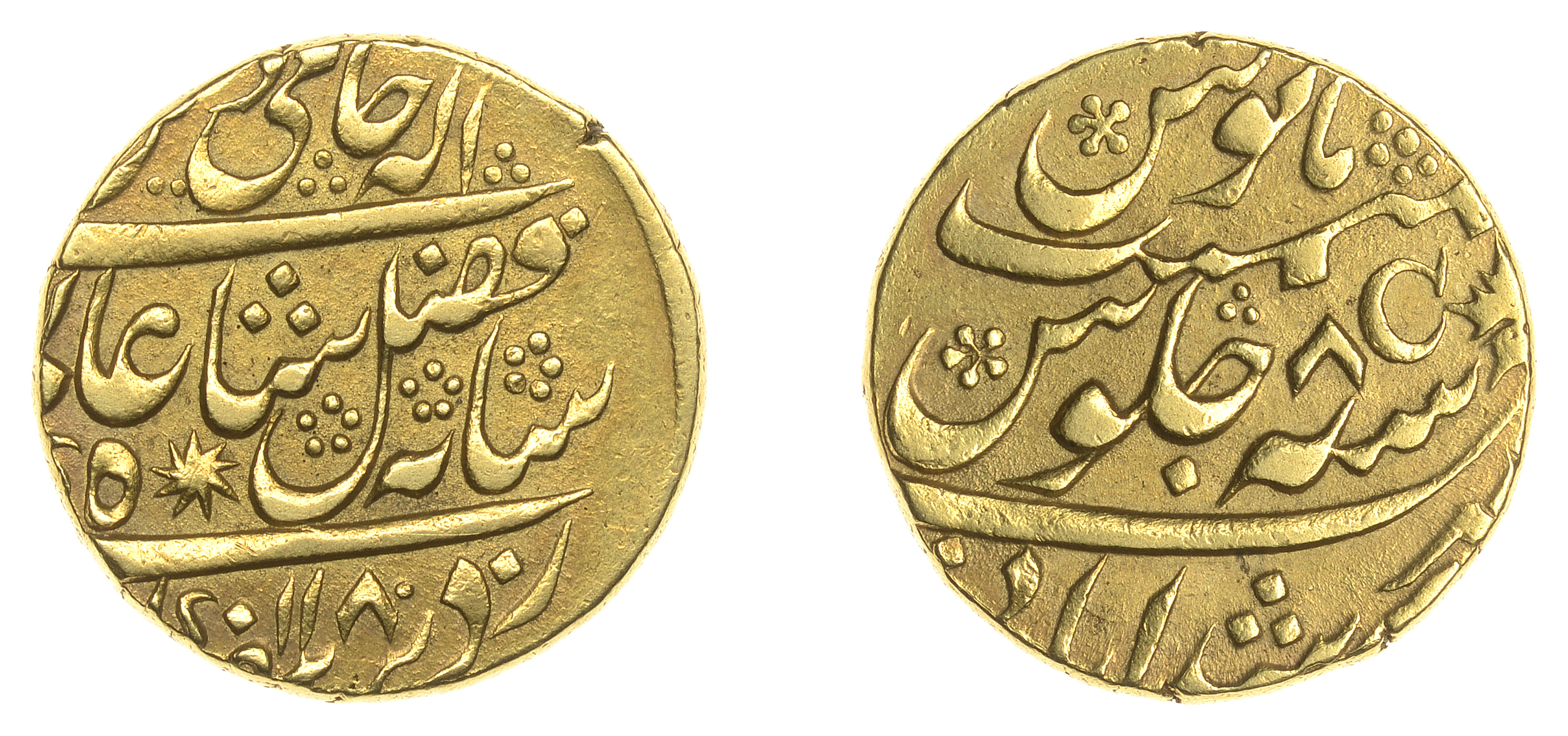The highly important and unique C-marked Mohur of Calcutta’s second gold coinage, 1766-8, first published in 1938 East India Company, Bengal Presidency, Calcutta Mint: post-1761 issues, Second gold coinage, gold Mohur in the name of ‘Shah ‘Alam II (1173-1221h/1759-1806), 1180h, yr 8 [1766-7], ‘C’ differentiation mark, naming Murshidabad, sikka zad bar haft kishwar saya fazl ilah hami din muhammad shah alam badshah [defender of the religion of Muhammad, Shah ‘Alam emperor, shadow of the divine favour, put his stamp on the seven climes], rev. zarb murshidabad sanah 8 julus maimanat manus [struck at Murshidabad in the 8th year of his reign of tranquil prosperity], C to right of regnal year, 11.65g/6h (Prid. 15, this coin illustrated [Sale, lot 569]; Stevens 2.7, this coin illustrated; Stevens website image 1298, this coin illustrated; KM. A94, this coin illustrated; F 1526, this coin illustrated). Obverse struck very slightly off-centre, otherwise very fine and exceptionally rare, a very significant piece and the only definitively known C-marked coin extant £30,000-£40,000 --- Provenance: R.D. Wills Collection, Glendining Auction (London), 6-8 December 1938, lot 212 A. Menjou Collection, Kreisberg/Schulman Auction 1 (New York), 25-6 January 1957, lot 1587 F. Pridmore Collection, Part II, Glendining Auction (London), 18-19 October 1982, lot 569 Taisei/Baldwin/Gillio Auction 24 (Singapore), 27 February 1997, lot 640, label. Owner’s ticket and envelope. Literature: Illustrated in Fred Pridmore, The Coins of the British Commonwealth of Nations...Part 4, India, Volume I, p.232. Illustrated in Paul Stevens, The Coins of the Bengal Presidency, p.32 Illustrated in Paul Stevens, The Coins of the English East India Company, Presidency Series: A Catalogue and Pricelist, p.13 Illustrated in George Cuhaj et al, South Asian Coins and Paper Money, Indian Edition, p.428 Illustrated in Art Friedberg et al, Gold Coins of the World from Ancient Times to the Present, p.523. In 1765 the Company was granted tax collecting rights in Bengal, Bihar and Orissa, which meant that the active mints of Murshidabad, Patna, Dacca and Calcutta began to fall under its control. Within a few years all four mints were ordered to strike identical coins naming Murshidabad, to try to combat profit-taking by the shroffs when exchanging old coin for those with the latest regnal year. That said, the shortage of silver at Calcutta caused the local council to propose a gold coinage, which was authorised in June 1766 and declared legal tender on 30 July. The Calcutta mint master, Alexander Campbell, who took up his post in November 1764 and oversaw activities there until ill-health forced him to step down in December 1767, had wanted to fix the relative value of gold to silver at 1:15 but was overridden by the board, which wanted one mohur to have the same value as 14 rupees. The coinage was not a success, however, partly because Calcutta had no skills to refine gold and by May 1768 the increased value of silver meant that the new gold mohurs were being publicly traded in the bazaar for 13 rupees 12 annas. Murshidabad and Patna ceased to coin gold in June and the entire issue was recalled from circulation in September, with the Court of Directors in London specifying that silver should become the only measure of commerce in Bengal; gold may be coined but it was not to have any fixed value placed upon it and should always be considered as bullion. The intriguing feature of these coins is the large C differentiation mark they bear, which the shroffs would have been keenly aware of. Pridmore speculated that the C indicated a coin authorised by the English Government of C[alcutta], perhaps a tricky interpretation as the city would have been known to locals and shroffs as Kalkata; Stevens mentions a possible association with Robert Clive, Governor of Bengal, who was resident in Calcutta from May 1765 to January 1767, and whose skills as a ruler were offset by vanity and corruption; a third possibility might be the mint and assay master himself, Alexander Campbell


